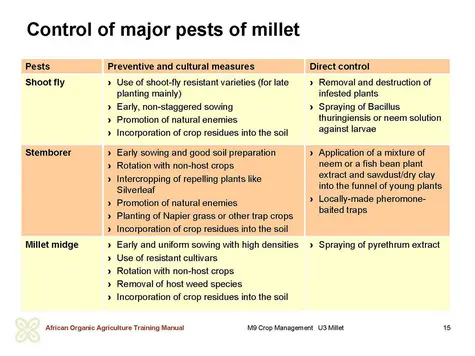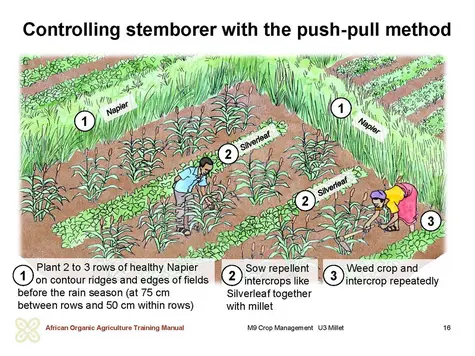Effective pest management
Shoot fly, stemborer, earworm and millet midge are the most important pests in millet, but also grasshoppers, locusts, white grubs and various butterflies can attack the crop. Birds are also important millet grain pests.
The sorghum shoot fly (Atherigona soccata) is also known to attack millets. It lays single cigar-shaped eggs on the undersides of leaves of young millet plants between the 1- to 7-leaf stages. The eggs hatch after only a day or two, and the larvae feed on the shoot tip. Feeding activity by the larvae results in wilting and drying of the young plant leaving a dead heart (central leaf develops into a dead heart and comes out easily on pulling). If the dead heart is plucked, it releases a bad odour. If the plant builds side tillers, they may also be attacked. The adult shoot flies resemble small houseflies.
Infestations are especially high when millet planting is staggered due to erratic rainfall. Temperatures above 35 °C and below 18 °C reduce shoot fly survival, as does continuous rainfall. Parasitic wasps and several species of spiders are important predators on eggs. Therefore, these natural enemies should be encouraged through maintaining strips with flowering plants around the fields. To reduce carry-over from one season to the other the crop residues should be collected and destroyed after harvest and other sources of mulch should be used in place of the millet or sorghum residues. If available, shoot-fly resistant varieties should be used.
Stemborer (Coniesta igenfusalis) is an important pest of millet, especially of pearl millet. The larvae feed on the growing points, leaves and stems of the plants at different growth stages, resulting in dead hearts. Destruction of crop residues through incorporation into the soil and good soil preparation contribute to control of the stemborer. Proper crop rotation breaks the pest’s life cycle. Mixed cropping of millet with other species also confuses the pest. Promotion of natural enemies with strips of insect-feeding flowering plants is also helpful, as several natural enemies attack this pest at different stages of its cycle.
The push-pull method, developed in East Africa, is very effective in controlling of cereal stemborer. This involves use of trap crops to attract stemborer colonization away from the millet plants (pull) and intercrops to repel the pests (push) as it is practiced for other cereals. Examples of trap crops are Napier grass, Sudan grass and molasses grass (Melinis minutiflora). They are planted in three rows around the millet fields. Whereas the fodder legume silverleaf, Desmodium uncinatum, which acts as repellent, is intercropped between the rows of millet. Direct control is possible with application of neem during the evening.
Also, inexpensive, locally-made pheromone-baited traps can be efficient in controlling stemborers. Placing simple locally made pheromone-baited traps along fences, or in the field, disrupts the mating activity of the stemborer moths by almost 90 % and results in a reduction of the population. The pheromone baited traps can also be used as a method for monitoring the stemborer adults to facilitate decision making on control of the larval stages. When the traps are placed in the field, 1,2 meters seems to be a good height at which the traps should be placed above the ground. Spacing between the traps in the field should be about 15 meters. Local extension agents can provide information on where and when to install the traps and where to obtain the pheromones.
Millet midge (Geiromiya penniseti) is abundant during the rainy season. The larvae of the fly feed on the developing seeds. As a result, infested grains do not develop and panicles have a blasted appearance. Appropriate rotation with non-host crops and intercropping reduce pest damage. After harvest crop residues should be destroyed to destroy the pest (although these would otherwise have been retained in the fields on the soil surface to protect the soil). Ideally fields are ploughed after harvest and shortly before sowing. Spraying of natural pyrethrum is possible, though not very economic.
Birds are the major pests of millet, especially Quelea spp. They prefer millet grains because of their small size. Preventive measures against bird attack include using cultivars with long, hard bristles. Risk of damage can be reduced by planting pearl millet away from tree lines or woods. Scaring of birds for several weeks before the harvest with efficient bird scaring methods is essential.
The lesser grain borer (Rhyzopertha dominica) and the khapra beetle (Trogoderma granarium) attack pearl millet at storage and can cause serious damage. Rats can also destroy harvested grains. For more information on control of storage pests see under paragraph 12 «Post-harvest handling».
Discussion on pest management in millet production
Ask the farmers, whether they have experienced any serious millet pest problems in the area. Have they noticed any
trends in pest problems over the years? Let them describe the signs associated with the pests and when they are most likely to attack the crop. Invite the farmers to also discuss any differences which they observe among different millet varieties and also discuss the control strategies which they use.
Making of a pheromone-baited trap
Develop a pheromone-baited trap as a stem borer monitoring system with the farmers. With the assistance of an entomologist or extension worker, the sub-activities could include the following:
- Finding out the possible pheromones and their sources for the particular area
- Constructing the pheromone-baited traps
- Field placement of the traps (distances between the traps, placement height etc.)
- Monitoring and evaluating effectiveness of the traps


 tap and then scroll down to the Add to Home Screen command.
tap and then scroll down to the Add to Home Screen command.